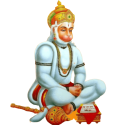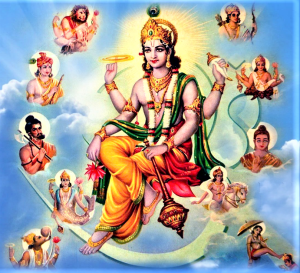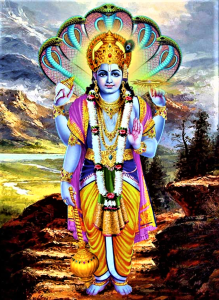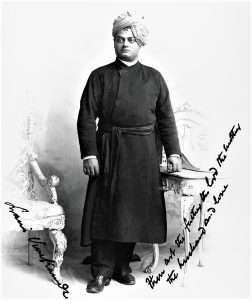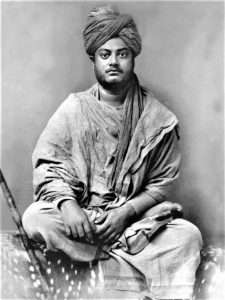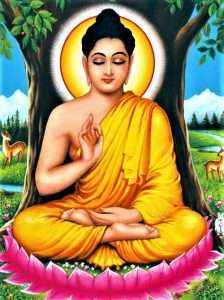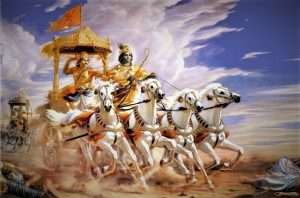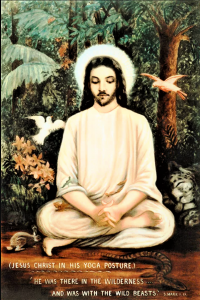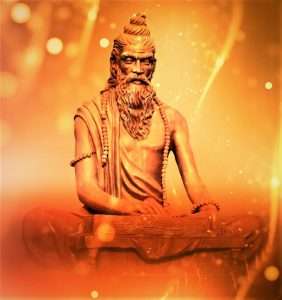Chakra
Chakra – The Sanskrit word ‘Chakra’ literally means wheel or circle. In the perspective of Yog, Chakra signifies the vortex or junction of Nadi (Pranic energy channels). They are also termed as psychic centers. According to some texts, there are so many Chakra in the human body but seven of them are the major ones. These seven Chakra are located in the astral body within the Brahma Nadi which is the innermost Nadi of Sushumna Nadi. Their location is associated with the spinal cord in the physical body.
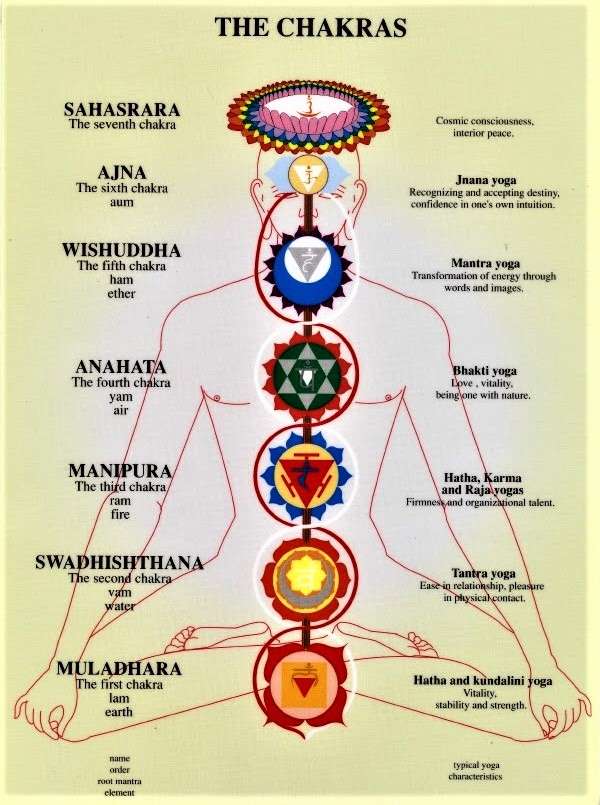
Seven Chakra – There are many Chakra in each human being but they are not developed. This simply means that the possibility of Chakra unfoldment is there in each human but it is under development in most of us. Only with the sincere practice and disciplines of Yog, Chakra develop and eventually reflect. This is similar to a growing child whose certain organs begin to develop and function only after a certain age. All Chakra already exist in a subtle state but one can feel and understand Chakra during concentration and meditation only. Chakra is also called subtle centers in the Sushumna Nadi. A particular Tattva (Element), presiding deity, a certain animal which denotes the qualities, Tattva or Guna of that particular animal and so on are associated with each Chakra. Of all Chakra, there are seven important Chakra – Mooladhara, Svadhisthana, Manipura, Anahata, Vishuddhi, Agya and Sahasrara of which Sahasrara is the seventh and the chief Chakra. There is a special point between Agya and Sahasrara Chakra which is called Vindu Visarga. Vindu is a not a Chakra but only a location/point from where Amrita (Divine nectar) secretes which bestows immortality. These seven Chakra correspond to the Urdhva Loka (Seven higher planes of existence – Bhu, Bhuvah, Svah or Svarga, Maha, Jana, Tapa and Satya Loka) and Saptabhumi (Seven grounds of knowledge – Subecha, Vicharana, Tanumanasa, Sattvapati, Asamsakti, Padartha bhavana or Padartha bhavini and Turyaga or Turiya) of Vedanta. Mooladhara to Vishuddhi are the centers of Pancha Bhuta (five elements) – Prithvi (Earth), Jala (Water), Agni (Fire), Vayu (Air) and Akasha (Ether). The Adho Loka (Seven lower planes of existence/ underworlds) – Atala, Vitala, Sutala, Talatala, Rasatala, Mahatala and Patala Loka are below Mooladhara Chakra. The Adho Loka refers to some minor Chakra in the body which are controlled by the Mooladhara Chakra. The minor Chakra are active in the animal kingdom. In humans Mooladhara Chakra is the basic level of awareness. Through Yog and meditation, when Kundalini awakens, She ascends on from Mooladhara to Sahasrara, all the seven Chakra. At every Chakra where Kundalini ascends, a Yogi experiences extraordinary Ananda (Bliss), attains special Siddhis (Psychic powers) and knowledge of spiritual dimension. When Kundalini reaches Sahasrara Chakra, then the Yogi enjoys the perfect supreme Bliss.
Minor Chakra – In the ancient books of Yog, some minor Chakra have also been named. They are – Adhara, Amrita, Ananda, Lalita, Balvana, Brahmadvara, Chandra, Dipaka, Karnamula, Gulhaha, Kuladipa, Kundali, Galabaddha, Kaladaada, Kaladhvara, Karangaka, Kalabhedan, Lalana, Mahotsaha, Manas, Talana, Mahapadma, Niradhara, Naukula, Prana, Soma, Triveni, Urdhvarandhra and Vajra etc. Some Hatha Yogi say that there are 144 Chakra in the human body. These minor Chakra are controlled by the Mooladhara Chakra. Like the major seven Chakra, these minor Chakra also correspond to the Adho Loka (Seven lower planes of existence/underworlds) – Atala, Vitala, Sutala, Talatala, Rasatala, Mahatala and Patala Loka. The Adho Loka are below Mooladhara Chakra. The minor Chakra are active in the animal kingdom.
Color of Chakra – The color of Chakra is a very doubtful topic. Some consider the Color of Chakra to be the same as the color of the petal on it. Some consider the color of Chakra and petal different. Some consider the color of Chakra and its petal as two different things; however, sometimes, the Chakra and the petal may have the same color. Some also consider that various objects associated with a Chakra form a unique combined color which is the color or aura of a Chakra. In different books the color of Chakra and petal have been mentioned differently. This makes the topic very confusing. From my study, I would suggest that the color of petals in a Chakra is the color of the Chakra and this is how it needs to be used also for meditation.
Chakra and Plexus – Swami Sivananda writes in “Kundalini Yoga” that plexus means interlacing of several nerves, arteries and veins in the body. The physical plexuses that are known to the medical science are Hepatic, Cervical, Brachial, Coccygeal, Lumbar, Sacral, Cardiac, Epigastric, Esophageal, Pharyngeal, Pulmonary, Lingual and Prostatic etc. Similarly there are plexuses or centers of Sukshma Prana in the Sushumna Nadi. All the functions of the body, nervous, digestive, circulatory, respiratory, genito-urinary and all other systems of the body are under the control of these centers in Sushumna. These are subtle centers of vital energy. These are the centers of consciousness. These subtle centers of Sushumna have their corresponding centers in the physical body. For example, Anahata Chakra which is in the Sushumna Nadi has its corresponding center in the physical body at the heart (Cardiac Plexus).
Petals on Chakra – Each Chakra has a particular number of petals. The number of petals in each Chakra is the number and position of the psychic Nadi around the Chakra. From each Chakra a certain number of special Nadi crops up. These Nadi appear as petals of lotus. Each petal of each Chakra has a Sanskrit alphabet inscribed on it. The Sanskrit alphabets are the sound produced by the corresponding vibrations of the Nadis. Every letter on the petals denotes the Mantra (Sacred sound vibration) of Devi Kundalini. These letters are latent in the petals. They manifest and the vibrations of Nadi are felt during deeper concentration. Altogether 50 Sanskrit letters are on the 50 petals of all Chakra. Perhaps this is why Sanskrit is considered the most ancient language. This is also proof that no language is human made but an evolution from a natural cause. The Chakra with their petals face towards Kundalini at the Mooladhara Chakra. When Kundalini is awakened, they face towards ascending Kundalini and Brahmarandhra (The crown of the head). The petals of Chakra always face the side of Kundalini. The number of petals of the lotuses are different – Mooladhara 4 petals, Svadhishthana 6 petals, Manipura 10 petals, Anahata 12 petals, Vishuddha 16 petals and Agya Chakra 2 petals respectively.
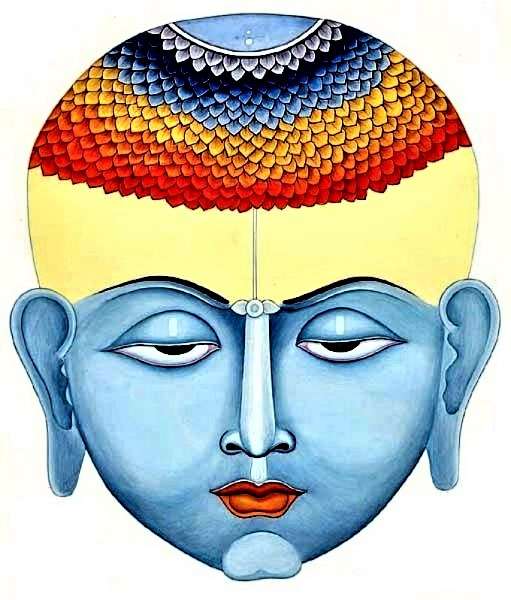
Brahmarandhra – The Sanskrit word “Brahmarandhra”, means the hole/pore of Brahman (Atman; soul). It is the dwelling abode of the soul. There are nine holes in the human body – 2 eyes, 2 ears, 2 nostrils, 1 mouth, 1 genital and 1 anus. The Brahmarandhra is the 10th hole. This is why it is also known as “Dasamadvara,” the tenth door or the tenth opening. The Brahmarandhra is a hollow place located at the crown of the head. In a new-born child, there is a very soft portion between the two parietal and occipital bones. This is the exact location of Brahmarandhra to be easily traced in newly born babies. When the child grows, the bones become fused by the growth. It is through this Brahmarandhra, the Atman enters the body to illuminate. When a Yogi at the time of death, consciously leaves his body, he separates himself from the physical body. Then this Brahmarandhra opens and Prana comes out through this special 10th hole. In this way the Yogi attains immortality and becomes free from the cycle of birth and death which is the goal of human life.
Granthi on Chakra – At specific Chakra are the Granthi (Knot) which represents the deeper roots of ignorance and attachment in an individual. Each aspirant must transcend these knots for Kundalini awakening. These Granthi are called Brahma Granthi, Vishnu Granthi and Rudra Granthi.
- Brahma granthi is at Mooladhara Chakra which implies attachment to overt selfishness, physical pleasures and material accumulation born of Tamas.
- Vishnu granthi is at Anahata Chakra which implies attachment to emotional ties with people and psychic visions born of Rajas.
- Rudra granthi is at Agya chakra which implies attachment to Siddhi (Psychic power) and Individual ego born of Sattva.
Bija Mantra of Chakra – Mantra means a sound revealed in meditation or in a higher state of awareness. Mantra has two qualities. In Sanskrit it is termed as ‘Varna’ and ‘Akshara’. Varna means color, form and Akshara means that which does not destroy and stays beyond time and space. Therefore, mantra is imperishable with an individual’s consciousness. Bija Mantra were the first syllables which appeared in deep meditation. The ionic emissions which form the petals of the Chakra, produce different inner sounds which were heard by ancient sages during meditation. The sounds of the petals form the letters of the Sanskrit language which explains why Sanskrit has been considered a meditational and transcendental language. Each Bija mantra is the essence of its associated Mantra. Some examples of Bija Mantra are –
Hraum – the symbolic sound of God Shiva
Dum – the mantra of Goddess Durga
Kreem – the mantra of Goddess Kali
Likewise, we have so many Bija Mantra in Tantra scriptures. These Mantra are sounds and thought forms existing within space. They have no literal meaning. In order to gain knowledge of a Bija Mantra there is a prescribed method through which only it can be experienced and known. The Mantra itself may be repeated in three ways – Vachik (aloud), Upanshu (whisper) and Mansik (mental). Each mantra and especially each Bija mantra has energy, musical note, colour, gem and astrological significance. The Bija Mantra of a Chakra represents the master key for full understanding and realisation of the significance of Chakra. The following are the Bija Mantra for the Chakra –
| Chakra | Bija Mantra & pronunciation | Number of petals |
| Mooladhara | Lam (Lum) | 4 |
| Svadhisthana | Vam (Vum) | 6 |
| Manipura | Ram (Rum) | 10 |
| Anahata | Yam (Yum) | 12 |
| Vishuddhi | Ham (Hum) | 16 |
| Agya | Om (Aum) | 2 |
| Sahasrara | Om (Aum) | 1,000 |
| Bindu (Between Agya and Sahasrara) | Om (Aum) | None; it is like a crescent moon |
Meditation on and repetition of the Bija Mantra with concentration on the respective Chakra has a profound psycho-physiological effect. These effects have been documented by researchers such as Dr Hiroshi Motoyama in Japan.
Myths about Chakra – At present time, so many myths about Kundalini and Chakra have been spread. Some of those are termed as Chakra balancing, Chakra aligning, Chakra blocking and unblocking, Chakra healing, Chakra purification and things like that. These concepts are very modern and western Intellectualization of the idea of Chakra including the identification of the colors of Chakra with those of rainbow. Many so-called experts of Yog offer these programs and many people flock to them under a false perception. This should be always kept in mind that Chakra and associated studies can never be intellectually tackled and wilfully manipulated. These things are in the hands of nature only to be worked out under strict and sincere guidance. The authentic experts of these techniques are always rare in the world and they offer these things to the deserving ones. Therefore, at the moment these terms do not have much relevance in the lives of people in general. However, Chakra and their importance for physical, mental, emotional, psychic and spiritual needs are always relevant. Some practices like awareness on Chakra, their locations and associated Mudra practices do have very deeper influences.
Benefits and implementation of Chakra practices – The practice of Yoga according to the scheme of Chakra is a very skilled approach. Some suggested tools for working on Chakra are well-regulated life style, moral precepts practically approached, Asana, Pranayama, Mudra, Bandha, Mantra, Dhyana, ritual, prayer and so on. These techniques are to be done for a longer period of time under the guidance of an expert only. They enhance and accelerate the process of evolution. These practices have healing effects as well. Chakra meditation is also not a common practice that anyone should do in regular life. Chakras are very powerful tools. They release tremendous amounts of psychosomatic responses which sometimes become overwhelming. Therefore, Chakra practices are special ones to be learnt properly first then slowly incorporated as daily practices.
Reliable books on Chakra – There are so many books on the information about Chakra. We recommend some ancient texts such as Shiva Samhita, Sat Chakra Nirupan and Chakra Kaumudi which defines Chakra and many other associated topics in detail. Apart from this there are so many books which describes Chakra such as books of Swami Sivananda, Swami Satyananda, Paramhamsa Yogananda and so on. The Serpent power by Sir John Woodrroff, About Chakra, the words of scriptures and enlightened masters are the only reliable sources. Swami Vivekananda has given a very detailed and important talk on Kundalini, Nadi and Chakra on His commentary on Yoga Sutra of Patanjali entitled Raja Yoga in the chapter “Psychic Prana”. We can study them and receive valuable information.
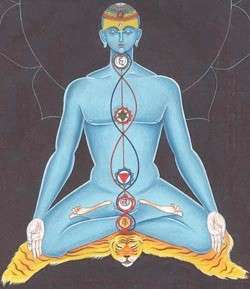
Some common hints about Chakra – Chakra have been detailed in different ways by different teachers of the world. However, there are some common points about each Chakra which requires proper analysis. Each Chakra is symbolized with a lotus flower with a certain number of petals. They are emissions of light particles representing the ionic intensity at that area of the human body. Perhaps because of the petal-like formation of the light discharge, the Chakra have been referred to as lotus flowers. In deeper states of meditation these petals can be seen, shining brightly. Swami Vivekananda once spoke to His friend that in Baranagar monastery, one day during meditation He had seen Ida, Pingala and Sushumna Nadi. Each Chakra corresponds to glands of the endocrine system. Although Chakra is situated in the spinal cord, the trigger points are in the front of the body. It is easier for us to concentrate on Chakra on the front part of the body compared to the corresponding places in the spinal cord. If we concentrate on these trigger points then it helps to stimulate the Chakra. Nadi, trigger points and Chakra are inter-connected. Chakra are very mysterious in nature and they need to be studied from various points of view. Each Chakra is associated with physical, mental and spiritual dimensions of an individual. These various dimensions include many points which help us understand the intricate topic of Chakra very easily. Some of those important points which are related to each different Chakra are the followings –
- Location – Each Chakra has a particular point within the spinal cord where it is situated and there is a particular location for the Chakra in the frontal part of the body to focus on.
- Petals (Nadi) – All petals of lotus are powerful and special Nadi that look like petals of a lotus.
- Element – Each Chakra relates to one particular element which is represented by a geometrical diagram.
- Sense organ – Each Chakra relates to one of the sense organs.
- Geometrical sign – Each Chakra has different geometrical signs which represent the energy of the Chakra.
- Animal – Each Chakra has an animal symbology which represents the developed state of the Chakra and the vehicle with movements.
- God and Goddess – Each Chakra has a presiding deity in pairs which represents the divinity of the Chakra and qualities associated with them.
- Sound vibrations and Bija Mantra – Each Chakra has a particular sound vibration. Sometimes, the particular element of the Chakra is considered the main sound vibration and the Seed Mantra (Bija mantra) of the Chakra.
- Alphabets of Sanskrit language – Each petal of Chakra has Sanskrit alphabets inscribed on them. They form all the alphabets of Sanskrit language hence Sanskrit is considered as a divine language.
- Relevance to planes of existence – Each Chakra relates to seven higher divine planes of existence such as Bhu, Bhuvah etc. which are divisions of one universe consisting of 14 planes.
- Color or aura – Each Chakra has an aura or color of its own which depends upon the aura or colors of all the components related to the particular Chakra.
- Area – Each Chakra corresponds to a certain area of the physical body.
- Gland – Each Chakra is linked with endocrine glands.
- Physical organs and System – Each Chakra associates with certain organs and systems of the physical body.
- Psychological aspects – Each Chakra relates to positive and negative psychological traits of human personality such as stability, ambitions and sympathy. This depends upon the evolution of an individual.
- Spiritual dimension – Each Chakra relates to certain levels of spiritual progress and awareness.
- Frequency – Each Chakra vibrates with a certain level of frequency.
- Awakening experience – When a Chakra opens then it has its own awakening experience.
- Psychic powers – When a Chakra opens then a certain level of psychic powers manifest to an individual.
The above explanations about each of the points can also be explained in many other ways. One can find this in different books. Like the above points and the meaning, there are more things related to Chakra that are also available. Actually, Chakra are highly mysterious and they can be described in various ways.
All seven Chakra in brief – Now we discuss each Chakra in brief. Please note that we have taken the help of Prof. John Woodroff’s book “The Serpent Power ” and Swami Satyananda’s book “Kundalini Tantra” for the images of Chakra. The brief information about each Chakra is hereunder –
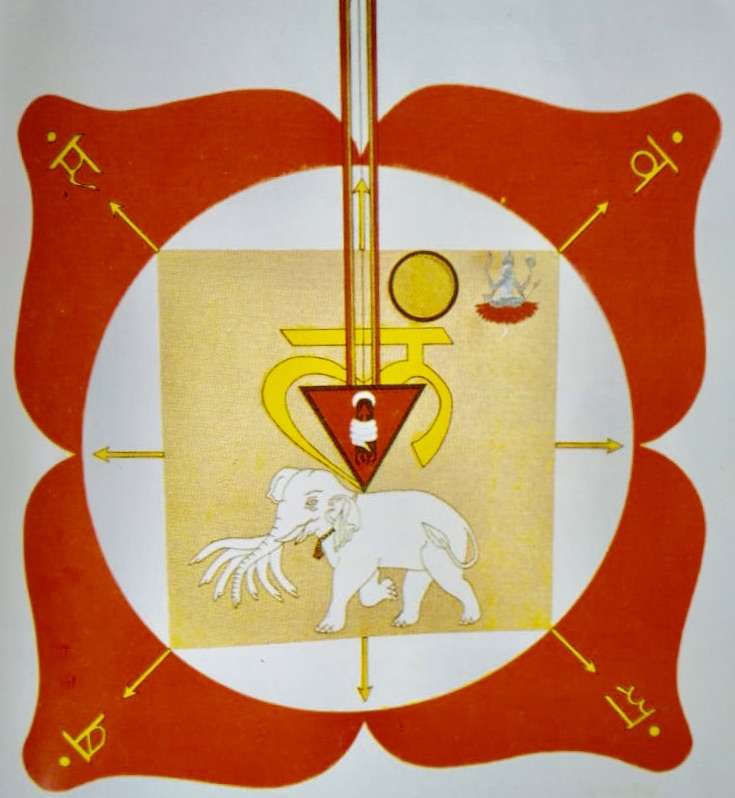
Mooladhara Chakra (Root Chakra/Root plexus) – Mooladhara Chakra is the most basic Chakra in humans but the highest in the animal kingdom. According to evolution from different species, we gradually transcend the minor Chakra. In human life we are born with the possibility of the experiences of higher Chakra from Mooladhara to Sahasrara Chakra. The Sanskrit word, Mooladhara is a combination of two words “Moola” meaning root and “Adhara” meaning base. Therefore Mooladhara means the base. This is the Adhara Chakra (support) as the other Chakras are above this. The Kundalini Shakti, which gives power to all Chakra, actually lies at this Chakra. Therefore, this is called Mooladhara or Adhara Chakra. The followings are the associated points about Mooladhara Chakra –
Location – In a male body it is at the perineum and in the female body on the posterior side of the cervix. At the base of the spinal column between the origin of the reproductive organ and the anus, two fingers above the anus and two fingers below the genitals, four fingers in width is the space where the Mooladhara Chakra is situated. The location is just below the Kanda (Root) and the junction where Ida, Pingala and Sushumna Nadi originate.
Number of petals (Nadi) and their color – Four, deep red like blood in color representing the four achievements of human life – Dharma (Virtue), Artha (Wealth), Kama (Desire) and Moksha (Liberation).
Sanskrit letters on petals – In clockwise movement on each petals – वं (Vam), शं (Sham), षं (Sam) and सं (Sam) inscribed in gold.
Tattva (Element) – Prithvi (Earth) represented by a yellow square.
Yantra – Yellow square.
Sound of element or Mantra – लं (Lam).
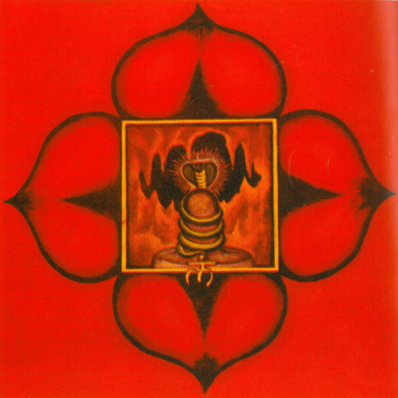
Sense organ – Nose.
Motor organ – Anus.
Tanmatra – Smell.
Kosha – Annamaya Kosha.
Vayu – Apana.
System – Excretory system.
Gland – Perineal glands.
Plexus – Sacro-coccygeal plexus.
Dhatu – Bone.
Goddess and God – Ganesh and Dakini.
Loka (Plane of existence) – Bhu.
Animal – Elephant with seven trunks.
Positive psychology – In the more refined state of Chakra it reflects maturity, firmness and consistency. Other symptoms are intense desire to live, confidence, material prosperity such as home, work and wealth, strength, proper analysis of the situations, concepts and conclusions, maturity, firmness, consistency, strong will, confidence, constancy, renewal, closeness to nature, fighting and coping spirit, efficiency for functioning in the world and solidity. Some physical symptoms are strong bones, joints and muscles, shiny hair, great physical strength, strong sexual power, vigor and grounding.
Negative psychology – In the unrefined state it reflects non-acceptance of new ideas and points of view. Other symptoms are insecurity of wealth, stability and safety, fear, tension, over worrying, threat, disconnection from reality, baselessness, hopelessness, too much attachment, overworry for security, routined life moving around eating, sleeping, sexually engaging, self-protection and lack of will. Some physical symptoms are laziness, weak bones, joints and muscles, weak lower back, sexual infirmity and inconfidence.
Awakening experiences – At Mooladhara Chakra Kundalini lies dormant. When through Yog and meditation, Kundalini awakens, she taps in the mouth of Susumna which brings special experiences to an individual which have been explained by many practitioners in different ways. In “Kundalini Tantra” by Swami Satyananda there is a description of Brahmachari Vyasdev who writes about the experience of Kundalini awakening in his book, “The science of the soul’. It says, “Sadhaka have seen the Sushumna in the form of a luminous rod or pillar, a golden yellow snake or sometimes as a shining black snake about ten inches long with blood red eyes like smoldering charcoal, the front part of the tongue vibrating and shining like lightning ascending the spinal column.” Swami Sivananda writes in his book, “Kundalini Yoga” that a Yogi, who has awakened Mooldahdara Chakra conquers the Prithvi Tattva (Earth element). The wise Yogi, who concentrates and meditates on the Mooladhara Chakra, acquires the full knowledge of Kundalini and the means to awaken it. When Kundalini is awakened at Mooladhara Chakra, he gets Darduri Siddhi (The power to rise from the ground). He can control his breath, mind and semen. His Prana enters the middle Brahma Nadi. All his sins are destroyed. He acquires knowledge of the past, present and future. He enjoys the natural Bliss (Sahaja Ananda). He has no fear of death from earth.
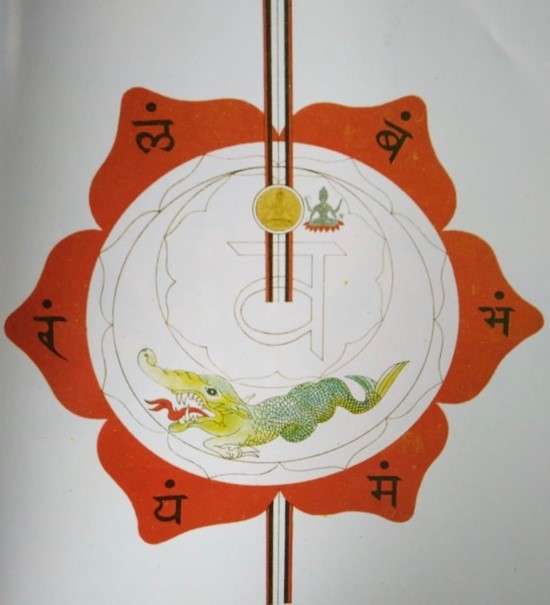
Svadhisthana Chakra is the second Chakra in ascending sequence. According to some Yogi, it is the actual place of Kundalini Shakti. The Sanskrit word, Swadhisthana is the combination of two words “Sva” meaning own and “Adhisthana” meaning abode, place or home. Therefore, Swadhisthana means one’s own home. It is located very close to Mooladhara so it is also responsible for Kundalini awakening at Mooladhara Chakra. The followings are the associated points about Svadhisthana Chakra –
Location – At the base of the spinal column is the coccyx or tailbone. At that level there is just like a small bony bulb which can be felt exactly above the anus. This is the point of Svadhisthana Chakra. It is very close to Mooladhara Chakra in both the male and female bodies.
Number of petals (Nadi) and their color – Six, red like vermilion in color representing the transcendence of sixfold mental impurities – Kam (Lust), Krodha (Anger), Lobha (Greed), Moha (Delusion), Mada (Vanity) and Matsar (Jealousy).
Sanskrit letters on petals – In clockwise movement on each petals – बं (Bam), Bham (भं), मं (Mam), यं (Yam), रं (Ram) and लं (Lam) inscribed in the color of lightening.
Tattva (Element) – Apas/Jala (Water) represented by a silver or white crescent moon, as Yantra.
Yantra – Silver or white crescent moon.
Sound of element or Mantra – वं (Vam).
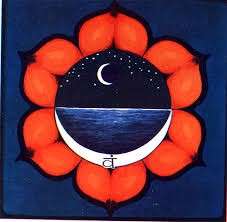
Sense organ – Tongue.
Motor organ – Penus/Vagina.
Tanmatra – Taste.
Kosha – Pranamaya Kosha.
Vayu – Vyana.
System – Reproductive, Urinary and Sexual system.
Gland – Testes, Ovaries.
Plexus – Pelvic plexus.
Dhatu – Fat.
Goddess and God – Rakini and Visnu.
Loka (Plane of existence) – Bhuvah.
Animal – White alligator with mouth of a crocodile and body of a fish.
Positive psychology – In the more refined state of Chakra it reflects desires, ambitions and activities. Other symptoms are active imagination, innovative creativity, impressive attitude, enthusiasm, good thoughts, feelings and emotions, motivated by joy, passionate towards life, longing for beauty and sensuous pleasure, good relationships, varieties in life, material fulfillment, qualitative change in life situations, healing abilities, guiding quality, change of place either for the purpose of work or travel, engagement is various kinds of concepts and flexible attitude. Some physical symptoms are good bowels and bladder function, cheerfulness, sound functioning of adrenal gland, kidneys, lymphatic system and menstrual secretions.
Negative psychology – In the unrefined state it reflects absence of self-control. Other symptoms are emotional and mental dependence, mental unevenness, inability to accept changes that life may bring, intense feelings and emotions, sexual guilts, obsession, addiction, disappointments and wavering thoughts. Some physical symptoms are lower back rigidity, imbalances in reproductive functions, discomfort in the pelvis, sluggish kidney, weak urinary system and irregular menstrual cycle.
Awakening experiences – Awakening of Svadhisthana Chakra is a release of some Karmic process which brings some overwhelming experiences such as excessive sexual desire. This is as a result of activation of the subconscious material in the mind. Therefore, the awakening of Svadhisthana Chakra presents many difficulties to a practitioner. Swami Muktananda’s experience is a very good example in this regard. Sometimes people misunderstand and attribute it to a disturbed mental condition. Swami Sivananda writes in his book, “Kundalini Yoga”, that there are many other psychic powers which reflects as the awakening of Svadhisthana Chakra such as no fear of water, control over water element, intuitive knowledge, control of senses, full knowledge of astral entities, complete absence of Sadvikar (Lust, Anger, Greed, Delusion, Vanity and Jealousy) and other mental impurities. Such a Yogi conquers death.
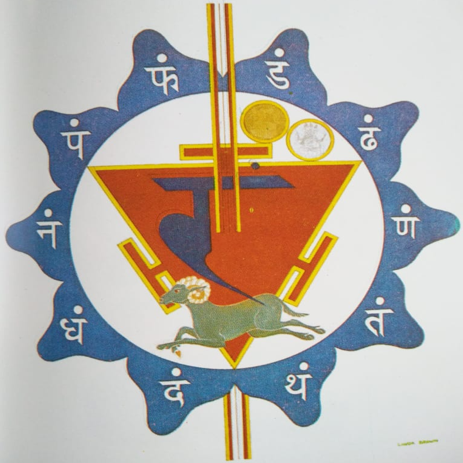
Manipura Chakra (Navel Chakra/Solar plexus) – Manipura Chakra is the third Chakra in ascending sequence. According to some Yogi, it is the storehouse of Prana. It is at this Chakra that the union of Prana and Apana happens. Ramakrishna Paramhamsa used to say to His disciples, that “Yoga is not possible if the mind dwells on ‘woman and gold’ (Physical desires and material pursuits). The mind of a worldly man generally moves among the three lower centers: those at the navel, at the sexual organ, and at the organ of evacuation. In this context woman represents Mooladhara Chakra, gold represents Svadhisthana Chakra and Naval (Self-esteem, Ego) represents Manipura Chakra. This is the ordinary awareness of individuals in the world. Of the three Manipura is the highest and it can be said to be a state of awareness with less pull of material gravity. After great effort and spiritual practice the Kundalini is awakened and taken up to Manipura and further onwards. The Sanskrit word, Manipura is the combination of two words “Mani” meaning jewel and “Pura” meaning palace. Therefore, Manipura means palace of jewels. This Chakra is responsible for spiritual transformation. The followings are the associated points about Manipura Chakra –
Location – It is located directly behind the navel in the spinal cord.
Number of petals (Nadi) and their color – Ten, bright yellow in color representing the awakening of the five Prana (Prana, Apana, Samana, Udana and Vyana) and five Upa Prana (Naga, Kurma, Krikar, Devadatta and Dhananjaya) and auspiciousness in all ten directions – Uttar/Udichi (North), Dakshin/Avachi (South), Poorva/Prachi (East), Paschim/Pratichi (West), Ishan (North East), Agneya or Agni (South East), Nairutya (South West or Demons) Vayavya or Vayu (North West), Urdhwa (Above/Skywards) and Adhah/Adharasta/Pataal (Below/Downwards).
Sanskrit letters on petals – In clockwise movement on each petals – डं (Dam), ढं (Dham), णं (Nam), तं (Tam), थं (Tham), दं (Dam), धं (Dham), नं (Nam), पं (Pam) and फं (Pham) inscribed in dark blue color.
Tattva (Element) – Agni (Fire) represented by an inverted fiery red triangle with a Swastika (Auspicious symbol) in the shape of a “T” on each of its three sides.
Yantra – Red inverted triangle.
Sound of element or Mantra – रं (Ram).
Sense organ – Eye.

Motor organ – Feet.
Tanmatra – Sight/Form.
Kosha – Pranamaya Kosha.
Vayu – Samana.
System – Digestive system.
Gland – Adrenal.
Plexus – Solar plexus.
Dhatu – Flesh.
Goddess and God – Lakini and Rudra.
Loka (Plane of existence) – Swaha.
Animal – Ram/Sheep.
Positive psychology – In the more refined state of Chakra it reflects willpower, indomitable confidence and self-discipline. Other symptoms are optimism, control over thoughts, powerful emotion, belief in oneself, dynamism, vibrant energy and ability to produce ideas into material reality. Some physical symptoms are a healthy digestive system, proper metabolism, proper energy supply to the whole body and strong inner vitality.
Negative psychology – In the unrefined state it reflects absence of lack of willpower, confidence and self-discipline. Other symptoms are struggle for power, unwillingness, dissatisfaction, overactivity, judgments, rudeness, aggression, controlling attitude, intolerance, conservative attitude, possessiveness, hesitation, low-steamed and fear of accepting responsibilities. Some physical symptoms are poor digestion, problems in digestive organs such as liver, gallbladder and intestine, acidity, physical weakness, depression and deficient vitality.
Awakening experiences – Manipura Chakra awakening is the actual Kundalini experience as from this Chakra, ongoing spiritual progress becomes more reliable. When Kundalini Shakti arrives at Manipura Chakra, the individual gets a glimpse of the higher Loka (Planes of existence). Swami Sivananda writes in, “Kundalini Yoga”, that the Yogi who concentrates on this Chakra gets “Patala Siddhi”, can acquire hidden treasures and will be free from all diseases. He has no fear at all from Agni (fire). Even if he is thrown into the burning fire, he remains alive without fear of death. Other powers gained through the awakening of Manipura Chakra are knowledge of one’s own body, freedom from disease and control of Prana.

Anahata Chakra (Heart Chakra/Cardiac plexus) – Anahata Chakra is the fourth Chakra in ascending sequence. In Kundalini Yoga, Anahata Chakra is a center of higher importance, where Kundalini Shakti remains for quite a long time and the practitioner experiences the first glimpse of spiritual dimension as Ramakrisha Paramhamsa said, “The Kundalini, when awakened, passes through the lower centers and comes to the Anahata, which is at the heart. It stays there. At that time the mind of the aspirant is withdrawn from the three lower centers. He feels the awakening of Divine Consciousness and sees Light. In mute wonder he sees that radiance and cries out: “What is this? What is this?” Swami Satyananda writes in “Kundalini Tantra” that in this present age the consciousness of mankind is passing through a phase of Anahata. It means that in many people Anahata chakra has started to function, but there is a difference between functioning and awakening. In most people, Anahata is not completely active, but it functions slightly. Mooladhara on the other hand is very active and almost awake in the majority of people today. The Sanskrit word, “Anahata” in the perspective of Kundalini Yog means a purely mystical sound which is produced without any interaction between two objects. Hence it is also called “unstruck or unbeaten sound”. The sound produced in such a way is termed as, “Anhad Nada” in Nada Yoga. In the Gospel of Ramakrishna, the reference comes. It says, –
Prankrishna (to the Master) – “Sir, what is the Anahata sound?”
Master – It is a spontaneous sound constantly going on by itself. It is the sound of the Pranava, Om. It originates in the Supreme Brahman and is heard by Yogis. People immersed in worldliness do not hear it. A Yogi alone knows that this sound originates both from his navel and from the Supreme Brahman resting on the Ocean of Milk.
In many scriptures it is said that there is an inner sound which is transcendental in nature, and this sound is beginningless and endless. Anhad Nada (Sound) is such a sound which is referred to in this context. The followings are the associated points about Anahata Chakra –
Location – It is located directly behind the center of the chest in the spinal cord.
Number of petals (Nadi) and their color – Twelve, blue in color representing the cycle of twelve months and power of 12 suns in relation to a stable spiritual experience.
Sanskrit letters on petals – In clockwise movement on each petals – कं (Kam), खं (Kham), गं (Gam), घं (Gham) ङं (Anga), चं (Cham), छं (Chham), जं (Jam), झं (Jham), ञं (Nyam), टं (Tam) and ठं (Tham) inscribed in vermilion color.
Tattva (Element) – Vayu (Air) represented by a hexagon formed of two interlaced triangles.
Yantra – Smoky six-pointed star.
Sound of element or Mantra – यं (Yam).
Sense organ – Skin.
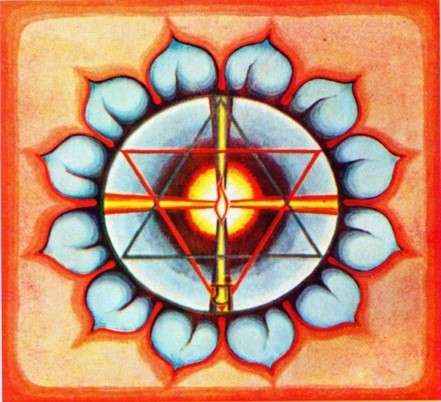
Motor organ – Hands.
Tanmatra – Touch.
Kosha – Manomaya Kosha.
Vayu – Prana.
System – Cardiovascular System.
Gland – Thymus.
Plexus – Cardiac plexus.
Dhatu – Blood.
Goddess and God – Kakini/Kali and Isha.
Loka (Plane of existence) – Maha.
Animal – Black antelope.
Positive psychology – In the more refined state of Chakra it reflects love, compassion, forgiveness and acceptance. Other symptoms are jealousy, grief, non judgment, artistic abilities, poetic traits, nobility of ideas, social sense, solidarity and attractive speech. Some physical symptoms are a healthy cardiovascular system, respiratory system, proper blood supply and strong immune system.
Negative psychology – In the unrefined state it reflects hatred, bitterness, judgments and absence of empathy. Other symptoms are inability to express love, inability to forgive, passive aggression, emptiness, loneliness, disconnection from people, loss of important relationships, demanding tendency, possessiveness, over-sensitivity, critical attitude, coldheartedness and intolerance. Some physical symptoms are heart problems, hypertension, problems of the respiratory system such as asthma, bronchitis, low energy in the whole body, weaker immune system, poor circulation and difficulty in breathing patterns.
Awakening experiences – Anahata Chakra awakening is the stable experience of Kundalini. When Kundalini Shakti arrives at Manipura Chakra, the individual gets an internal connection with the external world. He may hear sounds coming from other realms commonly known as, “Anhad Nada”. The individual may evolve as an inspired poet or artist, manifest immense love from his presence and ability to heal others. Swami Sivanand writes in, “Kundalini Yoga”, that He who meditates on this Chakra has full control over Vayu Tattva. He gets Bhuchari Siddhi, Khechari Siddhi, Kaya Siddhi, etc., (walking on the ground, flying in air, entering the body of another). He gets cosmic love and all other divine Sattvic qualities.
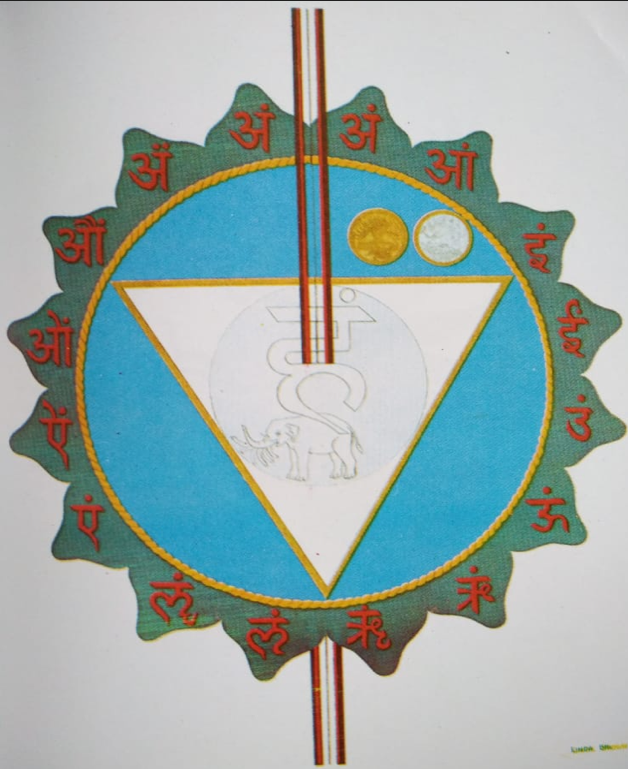
Vishuddhi Chakra (Throat Chakra/Cervical plexus) – Vishuddhi Chakra is the fifth Chakra in ascending sequence which is the end of elemental field of awareness as space being the fifth element connects to Vishuddhi Chakra. In Kundalini Yoga, Vishuddhi is also known as the “Poison and nectar center”. It is said that from Bindu Visarga (located at the hindbrain), the nectar drips down. This divine fluid has many different names such as “Amrit, Ambrosia, Soma, Madya, Sweet wine and so on. Between Bindu and Vishuddhi, there is another minor Chakra known as Lalana Chakra very closely related to Vishuddhi Chakra. When the nectar drops down from Bindu, it is stored at Lalana. This nectar is dual in nature; poison as well as nectar. As long as Vishuddhi Chakra remains dormant, this fluid drops further down to be consumed in the fire of Manipura Chakra, which results in decay, degeneration and death of body tissues. When Vishuddhi Chakra is awakened then the nectar is retained and used. The same nectar becomes the nectar of immortality which is the secret of youth and regeneration of a Yogi’s body. The Sanskrit word, “Shuddhi”, makes Vishuddhi. The word “Shuddhi” means to purify. Hence “Vishuddhi” means pure and purest. Vishuddhi Chakra is the place where purification of all opposites such as pain-pleasure, health-sickness, mortality-immortality and so on takes place. The followings are the associated points about Vishuddhi Chakra –
Location – It is located directly behind the throat pit in the spinal cord.
Number of petals (Nadi) and their color – Sixteen, purple in color representing the youth of 16 years with extreme purity of body and mind.
Sanskrit letters on petals – In clockwise movement on each petal – अं (Am), आं (Aam), इं (I), ईं (Eem), उं (Um), ऊं (Oom), ऋं (Rim), ॠं (Reem), ऌं (Lrim), ॡं (Lreem), एं (Em), ऐं (Aim), ओं (Om), औं (Aum), अं (Am) अः (Ah) inscribed in crimson color.
Tattva (Element) – Akash (Ether/Space) represented by a circle which is white like the full moon.
Yantra – White circle.
Sound of element or Mantra – हं (Ham).

Sense organ – Ears.
Motor organ – Vocal chords.
Tanmatra – Sound, hearing.
Kosha – Vigyanamaya Kosha.
Vayu – Udana.
System – Pharyngeal and Laryngeal System.
Gland – Thyroid.
Plexus – Cervical plexus.
Dhatu – Skin.
Goddess and God – Shakini and Sadashiva.
Loka (Plane of existence) – Jana.
Animal – Snow white elephant.
Positive psychology – In the more refined state of Vishuddhi Chakra it reflects purity, youth, pure expression of thoughts, imperative presence and higher discrimination. Other symptoms are good communication skills, connection to ethereal realm, inner guidance, pure consciousness, purity in creativity, eloquence of speech, calmness, serenity, harmonious voice, correct interpretation of spiritual secrets, right understanding of dreams and visions, attraction to true knowledge and pleasant voice. Some physical symptoms are sound thyroid function, proper function of vocal cords, larynx and pharynx and vibrant youth reflecting in the body and mind.
Negative psychology – In the unrefined state it reflects impurity, aging, improper expression, uninfluential and lack of discrimination. Other symptoms are difficulty in expressing feelings and emotion, timidness, underestimation of oneself, doubts, fear of communication, sense of guilt, lack of commitments, lack of freedom, self-restrictions and hyperactivity. Some physical symptoms are hyperthyroidism or hypothyroidism, throat problems, goiter, allergies, headaches, fatigue, cold, coughing, increase of phlegm, stammering and sore throat.
Awakening experiences – Vishuddhi Chakra awakening is a very high level of spiritual experience. When Kundalini Shakti arrives at Vishuddhi Chakra, the individual attains full knowledge of the scriptures, knowledge of past, present and future, sense of hearing through the mind, freedom from fear and imperishability. At the awakening of Vishuddhi Chakra, the associated Kurma Nadi (Tortoise channel) also awakens. Then the individual completely overcomes the necessity for food and drink. Swami Sivanand writes in “Kundalini Yoga”, that concentration on the Tattva of this Chakra is called Akasa Dharana. He who practices this Dharana will not perish even in Pralaya (Dissolution). He attains the highest success. He gets the full knowledge of the four Vedas by meditating on this Chakra. He becomes a Trikala Gyani (who knows the past, the present and the future).
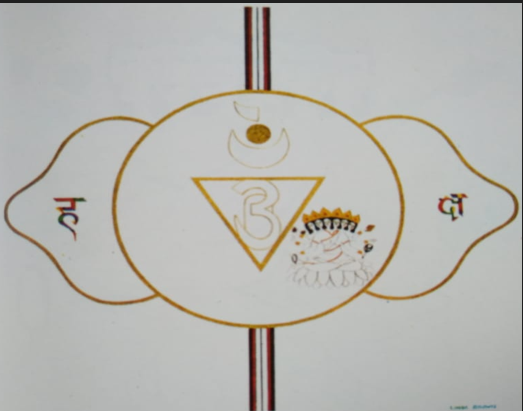
Agya Chakra (Third eye Chakra/Cavernous plexus) – Agya Chakra is the sixth Chakra in ascending order from which the experiences beyond elemental reality begin to reflect. It is the point of confluence where the three main Nadi (Channel) – Ida, Pingala and Sushumna merge together and become one flow up to Sahasrara Chakra (Crown Chakra). In the ancient texts of Yog, there is a description of three holy rivers; Ganga, Yamuna and Saraswati meeting at Prayag. In the context of human physiology, these three Nadis are represented by three great rivers Ganga (Ida), Jamuna (Pingala) and Saraswati (Sushumna). These three rivers converge at a place of confluence called Prayag or Triveni. According to Hindu belief system, every twelve years, when the Sun is in Aquarius, if one takes a dip at the point of confluence of the three rivers, the individual will become purified and attain liberation. Symbolically, the place of confluence corresponds to Agya Chakra. Agya Chakra is also termed as Divya Chakshu (Divine eye) or Gyana Chakshu or Gyana Netra (Eye of knowledge). Many people in India consider it as Shiva Netra (Eye of God Shiva) as God Shiva is considered the highest among meditators who is often seen sitting quietly with awareness fixed at Agya Chakra. Traditionally Agya Chakra awareness at the eyebrow center is one of the most powerful points of meditation. According to “Kundalini Tantra”, by Swami Satyananda Agya Chakra is more active in women as they are more sensitive, psychic, perceptive and able to predict coming events. Agya Chakra is also called the link between a Guru (Spiritual master) and his disciples. The Sanskrit word “Agya” means order or command. In spirituality command is the property of a Guru (Enlightened master). Hence this Chakra is also termed as Guru Chakra. The followings are the associated points about Agya Chakra –
Location – It is located exactly at the center of the head which is the very top of the spinal cord (Medulla oblongata).
Traditional point of concentration – Eyebrow center.
Number of petals (Nadi) and their color – Two, bright in color representing the two poles of duality.
Sanskrit letters on petals – On the left petal, the letter हं (Ham) and on the right petal, the letter क्षं (Ksham) inscribed in a silvery white color.

Tattva (Element) – Manas (Mind).
Yantra – Bright circle.
Sound of element or Mantra – ॐ (Aum).
Sense organ – Mind.
Motor organ – Mind.
Tanmatra – Mind.
Vayu – All five.
Kosha – Vigyanamaya Kosha.
System – Nervous system.
Gland – Pineal.
Plexus – Cavernous plexus.
Dhatu – Marrow.
Goddess and God – Hakini and Paramshiva.
Loka (Plane of existence) – Tapa.
Positive psychology – In the more refined state of Agya Chakra it reflects inspiration, intuitive insight, spiritual visions, duality of individual soul and universal soul and higher level of detachment. Other symptoms are higher degree of concentration, visualization, powerful mental control, strict moral discipline, self-introspection, total clarity, stable spiritual awareness, materialization of wish, total purity of mind and godliness. Some physical symptoms are good eyesight, healthy pineal gland, healthy functioning of the brain and entire nervous system .
Negative psychology – In the unrefined state of Agya Chakra it reflects unclarity, negative beliefs, irresponsibility, attachment, overanalysis and rigidity. Other symptoms are depression, fantasy, lack of faith, indecisiveness, becoming lost in one’s own beliefs, feeling stuck, lack of spiritual connection, overthinking, lack of sympathy, becoming too conceptual and too judgmental and misinterpretation of spiritual experiences. Some physical symptoms are headache, eye problems, strain, depression, nervous disorders and lack of physical and mental balance.
Awakening experiences – Agya Chakra awakening is a very high level of spiritual experience. When Kundalini Shakti arrives at Agya Chakra, then an individual experiences a state of absolute nothingness, where the phenomenal experiences of name and form, subject and object, do not exist. In this state even ego drops. This is almost like a void state which only an enlightened master can understand and enlighten further. The individual in this level of spiritual experience attains total detachment from the worldly reality and demonstrates tremendous spiritual capabilities. Often at Agya Chakra awakening, one sees a special bright light at the eyebrow center. Swami Sivanand writes in “Kundalini Yoga”, that he who concentrates at this center destroys all the Karmas of the past lives. The benefits that are derived by meditation on this Chakra cannot be described in words. The practitioner becomes a Jivanmukta (liberated man while living). He acquires all the 8 major and 32 minor Siddhi (Psychic powers). All Yogi and Gyani too concentrate on this center on the Bijakshara, Pranava! (OM). This is called Bhrumadhya Drishti (Gaze at the space between the two eye-brows).
Sahasrara Chakra (Crown Chakra/Cavernous plexus) – Saharara Chakra is the seventh Chakra in ascending order. According to some Yogi, Sahasrara Chakra is not a Chakra as it is thought to be. Sahasrara is the final experience and culmination of ascension through different Chakra. It is the original home of Kundalini Shakti where she unites with Shiva and attains the divine union. The union of Kundalini Shakti with Shiva at Sahasrara Chakra is the final experience of Yog. This divine union is beyond both the subjective and objective realities which is indescribable. Ramakrishna Paramhamsa used to say that the experience of Sahasrara Chakra can’t be explained as an individual whose Kundalini reaches Sahasrara Chakra becomes one with Brahmana. He loses his ego and own individuality. He is no more there as body and mind so how and who can explain the experience of Sahasrara Chakra. The experience here is the experience of only Brahman (The supreme God). It is the culmination of all Yogic efforts. The Sanskrit word “Sahasrara” means one thousand. The literal meaning of the word Sahasrara Chakra is a Chakra with one thousand petals which means one thousand Yog Nadi emanate from this center. However, Sahasrara Chakra is believed to have innumerable petals. All the 50 letters of the Sanskrit alphabet at other six Chakra are repeated here again and again on all Yoga Nadi. The word Sahasrara also implies that the significance of the Chakra is vast and unlimited. The followings are the associated points about Sahasrara Chakra –
Location – It is located exactly at “Brahmarandhra” which is at the center of the head; the very top of the spinal cord (Medulla oblongata).

Traditional point of concentration – Crown of the head.
Number of petals (Nadi) and their color – Thousand or infinite, red in color representing the infiniteness and limitlessness of experience.
Sanskrit letters on petals – Unknown.
Tattva (Element), Yantra, Sense organ, Motor organ, Tanmatra, Vayu – Beyond all.
Kosha – Ananadamaya Kosha.
System – Nervous System.
Gland – Pituitary.
Plexus – Hypothalamic pituitary axis.
Dhatu – Semen.
Goddess and God – Shakti and Shiva.
Sound of element or Mantra – ॐ (Aum).
Loka (Plane of existence) – Satyam.
Positive psychology – In the more refined state of Sahasrara Chakra it reflects perfect balance, detachment, experience of truth, unlimited powers and Godliness. Other symptoms are fearlessness, faith, enormous patience, peace, serenity, wholesomeness, wholeness, love, gratitude, infinite knowledge, oneness with everything, divine guidance, connection with God, total surrender and perpetual spiritual state. Some physical symptoms are a healthy nervous system, endocrine system, great sleeping patterns, strong energy and enthusiasm and overhaul improved health of body and mind.
Negative psychology – In the unrefined state of Sahasrara Chakra it reflects imbalance of personality such as superiority, over spirituality, illusion of truth and disconnection to worldly needs and responsibilities. Other symptoms are negative beliefs, hypoactivity, confusion about purpose in life, dissatisfaction with circumstances, lack of interest, egotism, boredom, narrow approach, rigidity, neglect of physical and emotional needs and lack of concentration. Some physical symptoms are nervous disorders, oversensitivity of sense organs, insomnia, foul dreams, fatigue and an unhealthy pituitary gland.
Awakening experiences – Sahasrara Chakra awakening is the highest level of spiritual experience. When Kundalini Shakti arrives at Sahasrara Chakra, an individual goes beyond all limits of body, senses and mind. That experience is known as the union between Shiva and Shakti. This union between Shiva and Shakti is the beginning of divine life. The Dhyata (Practitioner), Dhyeya (Object of meditation) and Dhyana (tMeditation) are all one and the same. There is only a single awareness. When Shiva and Shakti unite, nothing remains, there is absolute silence. Different traditions have their own way of describing this experience. Some call it Nirvikalpa Samadhi, some Nirvana, others as Kaivalya, Moksha, Enlightenment, Self-realization, Heaven and so on. Swami Sivanand writes in “Kundalini Yoga”, that when Kundalini is united with God Shiva at the Sahasrara Chakra, the Yogi enjoys Parama Ananda (Supreme Bliss). When Kundalini is taken to this center, the Yogi attains the superconscious state and the Highest Knowledge. He becomes a Brahmavidvarishtha (full-blown Jnani).

Bindu Visarga (Falling of drop) – Bindu Visarga is actually not a Chakra but a point between Agya Chakra and Sahasrara Chakra. In Kundalini and Kriya Yoga, it is considered as one of the most important locations. The word “Bindu Visarga” means ‘falling of drop or point’. Bindu is represented by the crescent moon and a white drop. The drop is the nectar dripping down to from the Bindu Visarga to Vishuddhi Chakra. Bindu Visarga is interconnected with Vishuddhi Chakra. The ten paired cranial nerves which emerge along the brain stem have their subtle origins within Bindu. The Vindu Visarga controls the whole visual, nasal, auditory and taste systems.
The location – The seat of Vindu Visarga is in the hind brain at the top back of the head. This is exactly the same spot where the traditional Hindu Brahmin keep a tuft (Small portion of hair always growing). In Sanskrit this tuft of hair is called Shikha. The tightening of the tuft develops sensation at the Bindu point.
Traditional point of concentration – At the top back of head.
Traditional symbology – A crescent moon on a moonlit night.
Yantra – A crescent moon on a moonlit night.
The seat of nectar – In Yog, we know that the secretion from Bindu can be awakened and controlled through different techniques. Then the vitality of body becomes independent of food. There are many examples of Yogi who have verified this possibility even under strict scientific observation.
With Love and Gratefulness (Founder Rohit Kumar)
Source – Ancient texts of Yoga, words of Swami Sivananda, Swami Satyananda, Swami Niranjanananda Sawaswati and personal study.
Hari Om Tat Sat!

